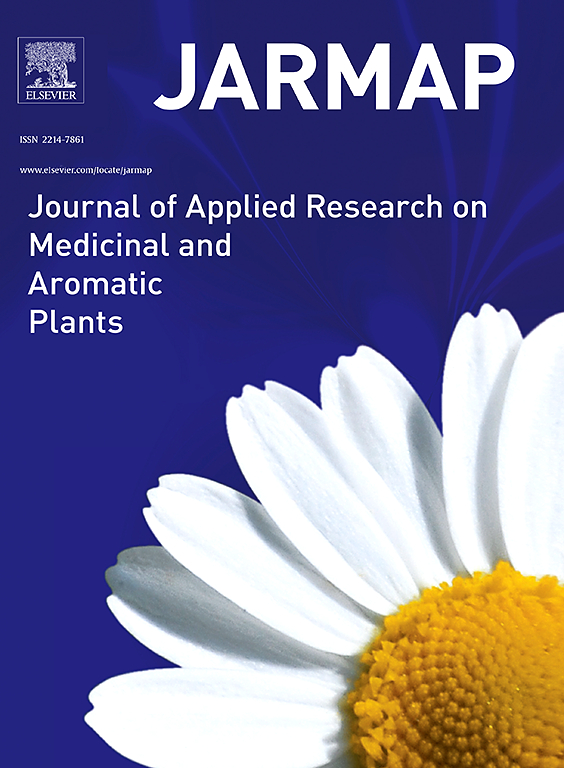Detection of saffron (Crocus sativus L.) adulteration using 1H NMR spectroscopy
IF 3.6
2区 农林科学
Q1 PLANT SCIENCES
Journal of Applied Research on Medicinal and Aromatic Plants
Pub Date : 2025-09-26
DOI:10.1016/j.jarmap.2025.100665
引用次数: 0
Abstract
Crocus sativus L. (saffron) is the most valuable spice worldwide, yet its limited production and high market value make it highly susceptible to adulteration with plant substitutes and synthetic dyes. In this study, 1H Nuclear Magnetic Resonance (NMR) spectroscopy was applied as a rapid, non-destructive technique for saffron authentication and detection of eight plant adulterants and one synthetic dye in a single experiment. Methanolic and hexane extracts were prepared to capture a broad polarity range of metabolites from authentic saffron, known adulterants, and commercial brands. Spectral comparison targeted key saffron markers, including picrocrocin, crocin, and crocetin. Most brand samples closely matched the authentic reference, with minor variations that can attributed to seasonal and geographical factors, whereas the ZK sample lacked diagnostic saffron peaks and instead displayed resonances consistent with Sudan IV and Arnica montana, confirming adulteration. Quantitative NMR (qNMR) was further employed for picrocrocin determination, and the method was validated in terms of selectivity, specificity, linearity (R² > 0.998), precision (intra- and inter-day RSD < 5.5 %), robustness (consistent results across varied scan numbers and relaxation delays). The method demonstrated a limit of detection (LOD) of 0.443 µg/mL and a limit of quantification (LOQ) of 1.342 µg/mL for picrocrocin, indicating high sensitivity and suitability for reliable quantification. Overall, these findings establish 1H NMR spectroscopy as a robust qualitative analytical platform for both authentication and detection of adulteration of saffron. Its integration into routine quality control and regulatory frameworks could strengthen consumer protection and ensure the integrity of high-value herbal and food products.
藏红花(Crocus sativus L.)掺假的1H NMR检测
藏红花(Crocus sativus L.)是世界上最有价值的香料,但其有限的产量和高市场价值使其极易受到植物替代品和合成染料掺假的影响。本研究采用1H核磁共振(NMR)技术对藏红花进行快速、无损的鉴定,并在一次实验中对8种植物掺假物和1种合成染料进行检测。甲醇和己烷提取物制备捕获广泛极性范围的代谢物从正宗藏红花,已知的掺假,和商业品牌。光谱比较针对关键的藏红花标记物,包括微藏红花素、藏红花素和藏红花素。大多数品牌样品与真实参考密切匹配,具有可归因于季节和地理因素的微小变化,而ZK样品缺乏诊断性藏红花峰,而是显示与苏丹IV和蒙大拿州山金车一致的共振,确认掺假。定量核磁共振(qNMR)进一步用于微芥子素的测定,并在选择性、特异性、线性(R²> 0.998)、精密度(日内和日间RSD <; 5.5 %)、鲁棒性(不同扫描次数和弛豫延迟的结果一致)方面对该方法进行了验证。方法检测限(LOD)为0.443 µg/mL,定量限(LOQ)为1.342 µg/mL,灵敏度高,定量可靠。总的来说,这些发现建立了1H核磁共振光谱作为鉴别和检测藏红花掺假的一个强大的定性分析平台。将其纳入常规质量控制和监管框架可以加强对消费者的保护,并确保高价值草药和食品的完整性。
本文章由计算机程序翻译,如有差异,请以英文原文为准。
求助全文
约1分钟内获得全文
求助全文
来源期刊

Journal of Applied Research on Medicinal and Aromatic Plants
Pharmacology, Toxicology and Pharmaceutics-Drug Discovery
CiteScore
6.40
自引率
7.70%
发文量
80
审稿时长
41 days
期刊介绍:
JARMAP is a peer reviewed and multidisciplinary communication platform, covering all aspects of the raw material supply chain of medicinal and aromatic plants. JARMAP aims to improve production of tailor made commodities by addressing the various requirements of manufacturers of herbal medicines, herbal teas, seasoning herbs, food and feed supplements and cosmetics. JARMAP covers research on genetic resources, breeding, wild-collection, domestication, propagation, cultivation, phytopathology and plant protection, mechanization, conservation, processing, quality assurance, analytics and economics. JARMAP publishes reviews, original research articles and short communications related to research.
 求助内容:
求助内容: 应助结果提醒方式:
应助结果提醒方式:


